
|
![]()
Greatest Films of the 1920s
1920 | 1921 | 1922 | 1923 | 1924 | 1925 | 1926 | 1927 | 1928 | 1929
Title Screen Film Genre(s), Title, Year, (Country), Length, Director, Description 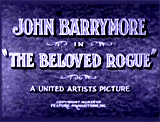





The Beloved Rogue (1927), 99 minutes, D: Alan Crosland
In this light-hearted swashbuckling adventure-comedy (competing with the similar films of the time by Douglas Fairbanks), John Barrymore starred as the fun-loving title character, Francois Villon, a reknowned medieval French poet. He was also known as a pickpocket, a hard-drinking adventurer-patriot, and one who loved France and its nobility, French women and cullture. When he jested about Duke Charles of Burgundy (Lawson Butt)), he was ousted from Paris by King Louis XI (Conrad Veidt in his US film debut), but then in exile, he saved the kingdom when it was later threatened by the rebellious Duke. Although wrongly sentenced to death, he still found time to romance Charlotte de Vauxcelles (Marceline Day), the king's ward - a typical damsel in distress. The film's sets were borrowed from The Hunchback of Notre Dame (1923).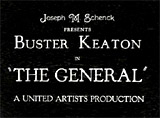



The General (1927), 75 minutes, D: Buster Keaton, Clyde Bruckman
Not only is it considered Buster Keaton's greatest film, it is also widely recognized as one of the true masterpieces of American cinema. The visually-stunning silent film is undoubtedly one of the greatest comedies ever made, with non-stop physical comedy and sight gags, shot almost entirely aboard moving trains. Keaton created this great comedy out of an authentic episode of American history during the Civil War - a story about a famous locomotive, though in real-life the locomotive was stolen by the Confederates. The two things devoted Confederate engineer Johnnie Gray (Buster Keaton) loved most in the world were his Southern belle sweetheart Annabelle Lee (Marion Mack) and his beloved locomotive named The General. When Northern spies stole the latter (with his kidnapped, tied and gagged girlfriend on board) behind Southern lines (and taken North), the intrepid Confederate heroically risked his life. He masterfully hijacked another locomotive, pursued them, and single-handedly took on the entire Union army in order to rescue both of his loves. The most spectacular and expensive shot in all of silent film history was the climactic crash of the pursuit train into the Rock River. Filmed against a backdrop of magnificently photographed Civil War battle scenes, it also contained one of the great chase sequences in movie history. The acrobatic stuntwork, Keaton's deadpan expressions, location photography and sight gags are remarkable.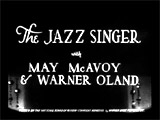


The Jazz Singer (1927), 88 minutes, D: Alan Crosland
Legendary, milestone revolutionary film, known as the first sound motion picture - literally, the first feature film to utilize Synchronous Sound. In actuality, it was a part-talkie with only a few musical sequences and one ad-libbed, conversational sequence. With Al Jolson in his film debut. Precipitating a split with his orthodox Cantor father (Warner Oland) and mother Sara Rabinowitz (Eugenie Besserer), young Jewish son Jakie Rabinowitz (Al Jolson) left his home, took a new name - Jack Robin - and entered show business as a Broadway singer of popular/secular music. When his father fell ill on Yom Kippur, and the night of his Broadway opening, Jakie returned home and took his dying father's place in the synagogue to perform the Kol Nidre. Contained the classic line: "You ain't heard nothin' yet!" Tunes included "My Mammy," "Dirty Hands, Dirty Face," "Toot, Toot, Tootsie Goodbye" and "Blue Skies."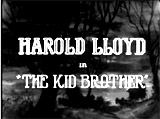



The Kid Brother (1927), 82 minutes, D: J.A. Howe, Ted Wilde
This comedy, considered by some to be Harold Lloyd's best feature film, featured a series of gags, pratfalls, and daring physical stunts. A slender, bashful, cleverly witty, bespectacled Harold Hickory (Lloyd), the "kid brother," felt inferior to his two brawny and athletic older brothers, Olin (Olin Francis) and Leo (Leo Willis). His widowed father Jim (Walter James), was the county sheriff in the rural mountain town of Hickoryville. In a search for approval and acceptance, Harold eventually proved himself after subduing a thief - burly carnival strongman Sandoni (Constantine Romanoff), saving his wrongly-accused father from being hanged, recovering the stolen money, and winning the heart of Mary Powers (Jobyna Ralston) from a traveling Medicine Show in town.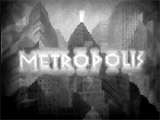



Metropolis (1927, Germ.), 120 minutes, D: Fritz Lang, remade in 1984 with rock music and selective color tinting
A stylized, visually-compelling, melodramatic silent film set in the 21st century city of Metropolis - Lang's German Expressionistic masterpiece helped develop the science-fiction genre. The luxurious, futuristic city of skyscrapers and bridges was stratified and divided into an upper, elite, privileged class and a subterranean, nameless, oppressed, ant-like worker/slave class. Freder (Gustav Frohlich), the young son of a ruling, aristocratic capitalist Master Joh Fredersen (Alfred Abel), discovered the miserable life of the proletariat when he noticed a beautiful young woman Maria (Brigitte Helm) with a group of worker children and pursued her into the squalid, labyrinthine underground slums. The wistful, Christ-like young woman urged her comrades to peacefully await their salvation. After discovering their meeting, Freder's father instructed mad scientist Rotwang (Rudolf Klein-Rogge) to create an evil robotic Maria look-alike that would manipulate the workers, preach rebellion, and cause their elimination. The false Maria went beserk and incited the workers to revolt, causing a cataclysmic flood. Freder and the real rescued Maria led the worker children out of danger, and Joh Fredersen was convinced to reconcile with the workers - Capital and Labor united in Love.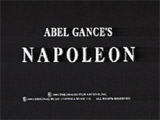


Napoleon (1927, Fr.), 235-378 minutes, D: Abel Gance
This silent film masterpiece by the legendary French filmmaker was restored to this length, but was originally intended as a biopic in six parts (of about 90 minutes each) about the life of French military leader Napoleon (Albert Dieudonné), from his childhood to his entry into Italy. This monumental epic was most notable for its revolutionary and creative visuals called "Polyvision" - multiple cameras recording the action that was projected panoramically onto three side-by-side screens. The triptych finale is rightfully a milestone in film history.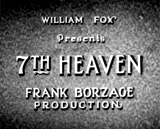




Seventh Heaven (1927) (aka 7th Heaven), 110 minutes, D: Frank Borzage
The ethereal and spiritual nature of idyllic romance was evidenced in this pure and simple melodramatic silent film - one of the first films to be nominated for Best Production (or Best Picture). The couple in love, in a 7th floor bohemian loft (nearer to the stars) were: Parisian sewer worker Chico (Charles Farrell) and abused street angel-waif Diane (Best Actress-winning Janet Gaynor). When the two lovers were separated by war (she ended up as a munitions worker) and he was blinded, they still remained in telepathic communication with their hearts and minds each night at 11. The film ended with the scene of their jubilant reconciliation in a shaft of light following the war's end.




Sunrise (1927), 97-110 minutes, D: F.W. Murnau
Subtitled, "A Song of Two Humans." The winner of the Academy Award for Best Artistic Quality of Production (a co-winner of "Best Picture"). An artistic, poignant, brilliantly-filmed, expressionistic, landmark silent regarding a love triangle. A country village farmer (George O'Brien) fell for the allure of a sophisticated, vampish seductress/temptress (Margaret Livingston) from the City, tempted by her under the moonlight in a swamp. He devised a murderous plan to kill his pure, innocent wife (Janet Gaynor) - by drowning her during a trip to the City. At the moment of attempted murder in the rowboat, he realized his love for his wife and couldn't complete the evil deed. In the City (of the Jazz Age), the couple made up and he won her back - but on the way home, a storm loomed up and took her from him - a seemingly-just punishment from Fate itself.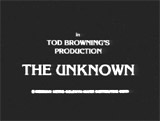



The Unknown (1927), 65 minutes, D: Tod Browning
In this bizarre and macabre horror tale of jealousy and deception, master of disguise Lon Chaney portrayed the character of Alonzo the Armless, an 'armless' knife-thrower in Zanzi's circus (he threw the knives with his feet). He fell in love with his young, sexy, gypsy girl-performing assistant Nanon (23 year-old Joan Crawford), the daughter of the circus manager-owner Antonio Zanzi (Nick de Ruiz). She had a pathological phobia and refused to be hugged, even by love interest strongman Malabar the Mighty (Norman Kerry). Alonzo was not actually armless - he was only pretending (his arms were strapped to his sides) because he was a fugitive and had two thumbs on one hand - a dead giveaway. Halfway through the film, Alonzo murdered Zanzi -- a crime witnessed by Nanon, who was only able to glimpse the killer's distinctively mutated thumb. Alonzo blackmailed a surgeon into amputating both of his arms, so he could further woo Nanon and escape detection. Meanwhile, Malabar cured Nanon of her phobia and they were to be married, something completely devastating to Alonzo. He vengefully plotted to get even - during Malabar's new act (pulling two horses running on treadmills in opposite directions), he pushed the stop lever, and the horses pulled dangerously on Malabar's arms. When Nanon intervened to help save him in the suspenseful finale, Alonzo came to her rescue and was trampled to death.Lost Film


The Way of All Flesh (1927), 94 minutes, D: Victor Fleming
A presumed lost film. Set in the early 1900s, Milwaukee bank clerk August Schilling (Best Actor-winning Emil Jannings), with a happy and respected family life and devoted wife (Belle Bennett) found himself in a predicament. While conducting bank business on a trip to Chicago, a flirtatious blonde seductress (Phyllis Haver) stole $1,000 of bank securities in his possession. Her crooked saloon owner accomplice beat him up and stole his identification, but lost his life during the struggle when hit by an oncoming train. In a twist of fate, the mangled body of the crook was identified as Schilling - and he was declared a dead hero who had valiantly defended himself. The shamed, devastated, and partially amnesia-suffering Schilling abandoned his family and hid out for twenty years, unable to return home. As an aged and unkempt tramp and trash collector, Schilling eventually returned, finding his son to be a grown-up world-class musician, and the family placing a wreath on his grave.





Wings (1927), 139 minutes, D: William Wellman
The first Oscar-winning film for Best Picture (Production), and the only non-speaking film ever to win the Academy Award (until The Artist (2011)). One of the most exciting silent dramas, with spectacular action and aerial photography of the dogfight/combat flying sequences (including actual WWI wartime combat footage), some of which were color-tinted. The film was the story of two American pilots from the same hometown (one rich, and one in the middle-class) who enlisted together in the Army Air Corps in World War I: Jack Powell (Charles "Buddy" Rogers), and David Armstrong (Richard Arlen). They were sent to France to battle the Germans. They both competed for the love of small-town girl next door Mary Preston (Clara Bow). Included a remarkable death scene of one of the two flyers, and reportedly the first film featuring a male-male kiss.